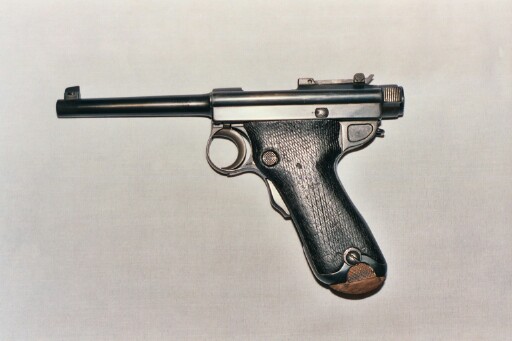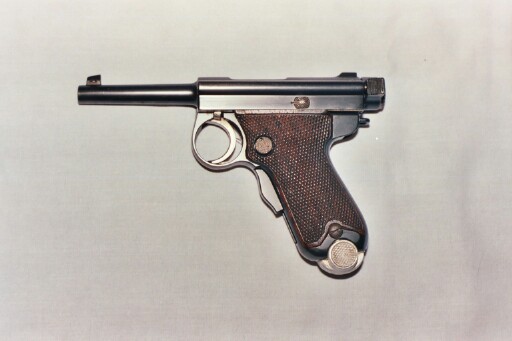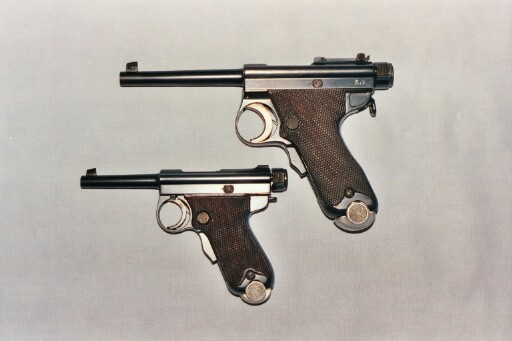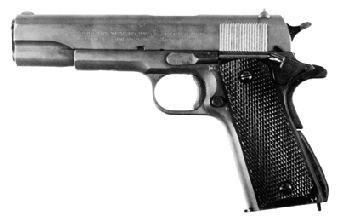Let’s take a look at handguns of WWII:
Germany:
P08 Luger (aka Parabellum P08), 9x19 mm Para, single action, 8 rounds.
Famous pistol. Few version, 7.65x22 Para version was relised as “commercial” version of P08.

P38 Walther, 9x19 mm Para, double action, 8 rounds.
Outstanding handgun, later Petro Beretta factory a bit changed this gun and maked his Beretta Brigadier then famous Beretta 92. Changes wasn’t great - P38 got two springs besides bolt, Beretta - one under barrell…

Walther PP/PPK, 22LR or 6.35mm auto (.25 ACP) or 7.65x17mm Auto (Browning) or 9x17mm (.380 ACP), double action, 7/8 rounds.
Relised as police weapon, these guns widely used in German army and was officially adopted in Navy.

Walther PP
To be continued…
Britan: Webley-Scott (among them - colt 1911 for .455)
USSR: TT-1930
USA:Colt - different modifications
Italy: Beretta
Finland: L-35
Japan: Nambu
Japan’s Nambus hawe plently versions: “Garandpa” Nambu mod. 1902, 8mm, Papa&Baby 7 mm with lots of modofications.
But these handguns was very expensive, abour two times more expensive, than “normal” Browning mod. 1910 for example.
Later all “family” of Nambu was modified and simplefied then adopted as Type 14.
In 1934 other handgun was adopted in Japanese army, Type 94.
So:

8 mm Nambu Grendpa. Look at wood based magazine - at least it’s funny…

Papa 7 mm Nambu

Papa and Baby Nambu…
There is pretty good site about nambus: http://www.carbinesforcollectors.com/nambu.html
Japanise firearms - is it very special firearms. Looks funny, with lots of pices, hard to maintain (but Japan Arisaka mod 1905 was most simpliest and “easy to assembly” bolt-action rifle at start of WWII), sometimes with wooden parts - is it just nightmare about mutated english firearms.
Practically all japanese machineguns WWII had inside special thing, that should oiling cartrige before cartrige will put in chamber…
Can’t look at it without tears… :lol:
Just for accuracy…
USSR finally adopted 1933 version TT, a bit modified TT 1930.
Also USSR got:
PK (Pistolet Korovina), 6.35[15.5 mm, blowback action, used for high Commy’s management and army commanders as “self-defence weapon”

In spring of 1941 USSR Army officially adopted PV (Pistolet Voevodina), (7,62х25 TT, 18 round in clip) as main army’s handgun, but this outstanding gun never prodused in enough quantity (about 1500 totally) - russian’s part of WWII was started just after few weeks after official adoptation.
I got luck tested this gun in middle of last summer and found it very good.

And, at least, Nagant revolver, 7.62, 7 rounds…
Yeah, you can shoot from it pretty well and accuratly, but after shooting all 7 rounds you’ll should ask for breack - emty cartriges ejected only “one by one” as well new cartriges you’ll put inside one-by-one too…
Durable, sharpshooting revolver, with powerfull cartrige, but from late century.
By the way, this gun was “double action”, at least after 1930 modification (late was “single” and “double” versions, “soldier’s” and “officer’s”). This “double action” feature was practically useless, at my experience, because in was very hard and pretty long “double action” and if you really need hit the target - better pull back hammer manually before shoot.
Anywas, in USSR army was more than 1 000 000 Nagants during WWII.

As I know, if you are speaking about PK(Korovin - 1926) - it was officially called TK(Tula, Korovin), and during WW2 among russian handguns were the handguns of Priluzkiy, Rakov (tested at fronts as Voevodin’s gun). And if you could - tell a link - about Voevodin’s gun.
Not a lot information about this gun… but this link got a bit, in Russian:
http://www.taina.sitecity.ru/ltext_0312220948.phtml?p_ident=ltext_0312220948.p_0312225018
Btw, this gun looks at photo more massive and large than in reality. At all dimensions this gun sized pretty quit as Beretta 92F, maibe even little smaller.
Voevodin’s gun mecanically equal a Mauser C-96 and, if i can use this term for hangun -is an C-96 “bullpup”.
Sad now, but when i hawe luck take this gun in hand i don’t maked any photos. Maybe late i will, if a still hawe second chance.
One example i saw in War-Historical Museum of Artillery in St. Petersburg, Russia, but not in exhibition, in closed funds. Maybe they will show this gun someday.
The Colt M1911 .45 ACP came into service in the year 1911, ofcourse. It is a very high quality weapon, durable under adverse conditions and reliable, and quite powerful as autos go. It has been such a good weapon with virtually no change over the many years that it was used in WWI, WWII, Korea, and Vietnam. It is still in service in portions of the US military and other parts of the world.

The famouse American soldier Private Alvin York killed an advancing patrol of Germans soldiers with his .45, then continued advancing and killed a total of 25 with his Colt .45 before capturing 132 German soldiers, all by himself. That was one amazing soldier eh?
Mauser C-98 (broomhandle)
[img]http://world.guns.ru/handguns/mauser_c96_9par.jpg
Type: Single Action
Chamber: 7.63x25mm Mauser (.30 Mauser); also 9x19mm Luger/Parabellum and 9x25mm Mauser (rare)
Weight unloaded: 1250
Length: 312 mm (with 140 mm barrel)
Barrel length: 140 mm (also 99 mm and other lenghts)
Capacity: 10 rounds in non-detachable box magazine (also 6 and 20 rounds)
The development of the C-96 began in 1893 or 1894. Most work had been done by the Federle brothers, who worked for the Mauser company. Final design appeared early in 1895 and had been patented by Paul Mauser. Production began in 1896. The C-96 had been offered for the German Military but failed. However, C-96 has a long and sucessfull story on the civilian market - being offered as a pistol-carbine, it outperformed in effective range most of contemorary pistols and revolvers, being especially popular with travelers and hunters in the areas where big animals are rare or absent at all. C-96 first saw military action during the Boer war in South Africa (1899-1902). During the First World War C-96 had been aquired by the German Army due to the lack of the stantart issue Luger P-08 pistols. It also had been used during the World War Two, by some second line troops of the Reichswehr (German Army). C-96 also had beeen widely exported - in the 1920s Soviet Russia purchased large quantities of the short-barreled (99 mm barrels) C-96s in 7.63mm, givint the name “Bolo-mauser” (from Bolsheviks’ Mauser) to all short-barreled C-96s. In 1930s China also purchased lots of the C-96s in 7.63mm, and also manufactured copies of the C-96 but chambered for .45ACP cartridge. Surprisingly, these copies were of quite good quality. Many C-96 clones were manufactured in Spain, mostly withouth any license, and mostly by the Astra. In the early 1930s Mauser engineers developed a select-fire version of the C-96, which had been used in limited numbers during WW2.
Technically, the C-96 is a recoil operated, locked breech, semi-automatic pistol. It uses short recoiling barrel with bolt, located inside the large barrel extension. The bolt and barrel are locked by the vertically tilting locking piece with two lugs, that locked into the recesses on the bottom of the bolt. The gun is hammer fired. Early guns had hammers with large, round shaped hammer headss with coned sides. The safety is located at the left side of the hammer and locks the hammer when engaged. The most recognisable feature of C-96 is a non-removable, fixed box magazine, located ahead of the triggerguard. Early models were made with 20, 10 or 6 round magazines, but soon 20 and 6 round models were dropped, and since 1905 or so only 10 round models werere manufactured. C-96 can be loaded with single rounds or from 10-rounds sripper clips. The only way to unoad the magazine was to work the slide all the way back and forward for each cartridge in the magazine. Two other notable features were the distinguishable shaped handle (which give the name “broomhandle” to all C-96s) and removable wooden shoulder stock/holster. Finally, most of the C-96 were fitted with ajustable rear sights, graduated up to 1000 meters. This, obviusly, was more of marketing feature, since at 1000 meters distance the average bullets spread was about 4 meters, but, due to high velocity ammunition (the 7.63mm Mauser round produced muzzle velocities of about 440 meters per second, or 1450 feets per second), the effective range was about 150 or 200 meters, especially with shoulder stock atached.
The C-96 took its final shape in 1912, when new type of safety (marked NS - “Neue Sicherung”) was adopted, along with shorter and wider extractor and smaler and lighter hammer. In 1915, due to World War, German Army purchased from the Mauser some 150.000 C-96s, chamberd for the army standart issue 9x19mm Luger/Parabellum round. These guns were marked with large red “9” digits on the both sides of the grip. In the 1931-32 Mauser engineers developed two latest versions of the C-96 - models 711 and 712. Main difference of these models was the adoption of the removable box magazines for 10 or 20 rounds. The Model 712 also featured a fire selector mechanism with the fire mode switch on the left side of the frame. Due to the high rate of fire in full auto (1000 rounds/minute) and light barrel, the full auto could be used with any practical effect only for short time and only with shoulder stock attached. These guns were used in limited quantities by German Army in Second World War.
In general, the C-96 is one of the most distinguishable semi-auto pistols in the history, also one of the first practical designs in its class. It was too heavy and too bulky, and slow to reload, but offered great effective range and firepower, along with good reliability. In short - it is what we usually call CLASSIC.
Belgium: Browning GP35 Hi-Power, 13 rounds, recoil operated pistol. Still used today.
Tinwalt - you’re wrong about Alvin York - of those 25 he killed about 6 with the pistol, and the rest with an Enfield M17 (.30-06)
Alvin York’s diary:
http://www.acacia.pair.com/Acacia.Vignettes/The.Diary.of.Alvin.York.html#October%208th%201918
I have to say that the Colt .45 and the Luger are my favorites. But thats just coz ive fired them both. I think the .45 is a bit better than the Luger but not by much. Both great pistols. 
The Colt is made with interchangeable parts, the Luger has to be hand-fitted. The locking mechanism in the Colt is internal and concealed, in the Luger it’s exposed. Get some dirt in a Luger and it won’t work.
The sights on the luger are…um… vestigial.
The grip angle on the luger is good for me, but many people can’t stand it.
There’s a reason that the Germans adopted the P38 as a replacement to the Luger - it’s a far better gun, and far more combat worthy (reliability etc).
IMHO, I’d have to go with the Browning GP35, since I’m a whuss with pistols and find .45ACP to be just too much gun. This limits me to a 9mm. So I might as well have an ergonomically OK design (for the time)which is extremely reliable, and 13 rds (5 more than the Luger & P38).
There’s also the Polish Radom, which looks externally rather like the Browning, and is also supposed to be quite good. I’ve never fired one though.
If you want to see the most finely made combat pistol of all time, look at an early Swiss luger (7.65Para). Exquisit workmanship, extremely accurate, and firing an anaemic cartridge which the Germans rejected (9mm Para is an un-necked 7.65 Para and was designed so that Luger would have to do the minimum re-tooling to produce a 9mm version).
The majority of IPSC raceguns nowadays are still based on the Colt 1911, so it’s a design that’s lasted.
I guess you meand that:

Real name - VIS vz 35. Comercial name M1935 Radom
9 mm Para. 8 rounds in mag.
Post-occupation german pistol,
![]()
Later polish VIS vz 35 maded for german army, simplyfied
![]()
I can’t say that looks like Browning HP… more looks like Colt 1911A2…
My own story with this sidearm happend in early 1990s. One guy, who collecting rusty weapon on WWII battlefields near St. Petersburg during discussion about M1911A2 with me said: Colt M1911A2 was used in WWII but for 9 mm Para. I said - “It’s impossible !” He shown to me rusty gun looks like little Colt .45 I was amazed. But no handgrip plates or marks on it… After little investigation i finally has found that poles got that gun in army during WWII and after occupation germans got same gun…
By interior that gun not same with Colt, but more same with Browning HP… anyway Browning has invented their both.
Btw - do you know that you can use P08 part as firearm without another part ? :lol: Just take out slide with barrel and bolt. Handgrip and trigger machanism with trigger guard - no needed in our experiment…
Barrel-bolt-slide enough to one-shoot use. You can put round in chamber, pull back that rounded things to arm that “sub-pistol”, lead barrel in target - and if you’ll press thing from below side of that “half-pistol” - it will shot… In Russia, where any civilians with handguns can be puneshed for illegal storage and/or carrying of firearms (about 3 years in jail) - that enough to send somebody in jail-cell if he/she will be with that top-half part of P08 in pocket.
British Webley MkVI .455. A design dating back to 1887, the MkVI was introduced in 1915 and despite being declared obsolete in 1932, it continued to see service during WW2. It was replaced by the Enfield .38 and the Browning 9mm. I love the design - it looks like a classic service revolver. For practical purposes though, I have no doubt the Browning was better.
(Source http://world.guns.ru/handguns/hg91-e.htm)

It was still on active service in 78 when I used it in NI. We had all sorts on issue.
Cheers for the info, 2nd of foot. That’s pretty good going for an 1880s design.
Mind, you, I recently read of the Delisle carbine being used in NI in the 1980s. Now there’s an odd one.
I think it was more to do with “all hand (guns) to the pumps” than operational value. We had a shortage of side arm at the time and pistols were withdrawn from Bns to go to NI, as I understand, to plug the gaps. So it does not take too much to go into the stores and find all those revolvers in boxes stored for a rainy day, and it was bucketing it down.
Two years latter the armourer indented for a Vickers part and got it. It had a little note added to it to say that they had not issued parts for the Vickers for a number of years. To us the surprise was that they still had them in stock.
:shock:
Which, the .455 or .38? I would imagine sourcing .455 ammunition would be a bit difficult.
There is something purposfully stylish about the squared off barrel of the Webley and Enfield revolvers.
I could not say. I was young and fired what the OC gave me. We had an excellent morning blapping off rounds for fun. Stood there firing side on with one hand like in the films. I think I hit the sand at 15m but may be wrong. 
I’ll post a few pictures of my Webley. Only reason the British Military replaced it was because the .455 round took too much training.
Just going to post the links because they are quite large.
http://img.photobucket.com/albums/v219/DerMann/webley9.jpg
http://img.photobucket.com/albums/v219/DerMann/webley4.jpg
http://img.photobucket.com/albums/v219/DerMann/webley8.jpg
http://img.photobucket.com/albums/v219/DerMann/webley3.jpg
http://img.photobucket.com/albums/v219/DerMann/webley2.jpg
http://img.photobucket.com/albums/v219/DerMann/webley.jpg
It fires a 265 grain bullet, and I think that the .45 ACP bullet is about 230 grains. The fps is lower, though. The .455 cartridge gets about 650-700 fps and the .45 gets 800+.

